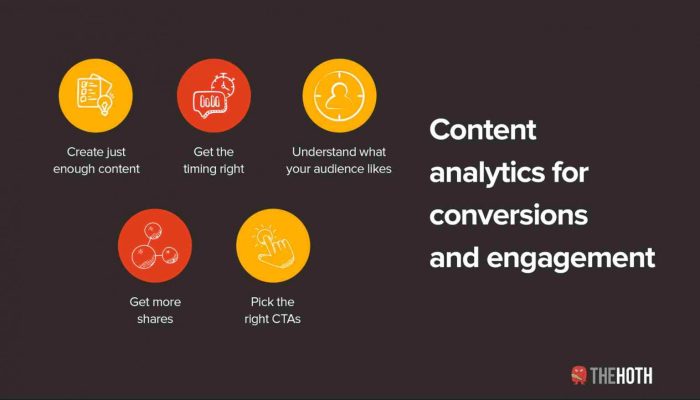Using Analytics to Measure Content Success kicks off our journey into the world of data-driven content strategies, where numbers tell stories and success is measured in metrics. Get ready for an eye-opening exploration filled with tips, tricks, and examples to up your content game!
Understanding Content Success Metrics

In the world of content creation, it’s crucial to understand the metrics used to measure success. These metrics provide valuable insights into how your content is performing and can help you make data-driven decisions to improve your strategies.
Pageviews
Pageviews are a basic metric that shows how many times a page has been viewed by users. The higher the number of pageviews, the more popular your content is. For example, a blog post with a high number of pageviews indicates that it’s resonating well with your audience.
Engagement Rate
Engagement rate measures how actively users are interacting with your content. This metric includes likes, comments, shares, and other forms of engagement. A high engagement rate signifies that your content is compelling and resonating with your audience on a deeper level.
Bounce Rate
Bounce rate indicates the percentage of visitors who leave your site after viewing only one page. A high bounce rate may suggest that your content is not engaging enough or that it’s not relevant to what the visitor was looking for. Lowering the bounce rate is essential for keeping visitors on your site longer.
Conversion Rate
Conversion rate measures the percentage of visitors who take a desired action, such as making a purchase, signing up for a newsletter, or downloading a resource. A high conversion rate indicates that your content is effectively driving users towards your goals.
Examples of Successful Content
- A viral video with millions of views and shares showcasing a brand’s product.
- An in-depth blog post that receives high engagement with comments and social media shares.
- An infographic that leads to a high conversion rate with visitors signing up for a webinar.
Implementing Analytics Tools

When it comes to measuring content success, having the right analytics tools in place is key to gaining insights and making informed decisions. Let’s dive into some popular analytics tools, compare their features, and explore their impact on content strategy.
Google Analytics
Google Analytics is a go-to tool for many content creators and marketers due to its robust features and user-friendly interface. It allows you to track website traffic, engagement metrics, conversion rates, and more. With detailed reports and real-time data, Google Analytics provides valuable insights to optimize content performance.
Adobe Analytics
Adobe Analytics is another powerful tool that offers advanced analytics capabilities for tracking and analyzing content performance across multiple channels. It provides customizable dashboards, audience segmentation, and predictive analytics to help tailor content strategies for specific target audiences.
Hotjar, Using Analytics to Measure Content Success
Hotjar focuses on user behavior analysis through heatmaps, session recordings, and surveys. This tool helps content creators understand how users interact with their content, identify pain points, and optimize the user experience for better engagement and conversion rates.
Implementing Analytics Tools
- Choose the right tool based on your content goals and audience demographics.
- Set up tracking codes and goals to measure specific content performance metrics.
- Analyze data regularly to identify trends, insights, and areas for improvement.
- Use A/B testing to optimize content elements and enhance user experience.
Interpreting Data Trends
In the world of content analytics, interpreting data trends plays a crucial role in understanding how well your content is performing and what adjustments need to be made for optimization.
Identifying Trends in Content Performance Data
- Look for consistent increases or decreases in key metrics over time.
- Compare performance across different content types or channels to identify patterns.
- Consider seasonality and external factors that may impact data trends.
Significance of Recognizing Patterns for Content Optimization
- Identifying patterns helps in making data-driven decisions for content strategy.
- Allows for timely adjustments to content based on performance trends.
- Optimizing content based on data trends can lead to improved engagement and conversion rates.
Examples of Interpreting Data Trends for Successful Content Strategies
- By analyzing data trends, a company discovered that video content consistently outperformed other formats, leading them to focus more on video production.
- Identifying a specific time of day when content received the most engagement helped a brand optimize posting schedules for maximum reach.
- Recognizing a drop in engagement following changes to content topics led to a pivot in strategy to align with audience preferences.
Setting KPIs for Content Success: Using Analytics To Measure Content Success
Setting Key Performance Indicators (KPIs) for content involves identifying specific metrics that will be used to measure the success of your content marketing efforts. These KPIs help you track progress, evaluate performance, and make informed decisions to improve your content strategy.
Aligning KPIs with Business Goals
It is crucial to align your KPIs with your overall business goals to ensure that your content efforts are contributing to the success of the organization. By setting KPIs that directly tie back to your business objectives, you can measure the impact of your content on key outcomes such as lead generation, brand awareness, customer engagement, and revenue generation.
Measuring Content Success Based on Defined KPIs
- Track Engagement Metrics: Measure metrics such as page views, bounce rate, time on page, social shares, and comments to gauge how well your content is resonating with your audience.
- Conversion Metrics: Monitor conversion rates, click-through rates, and form submissions to assess how effectively your content is driving desired actions from your audience.
- Performance: Analyze organic search traffic, rankings, and backlinks to evaluate the impact of your content on search engine visibility and website traffic.
- Customer Retention: Measure metrics such as repeat visits, email sign-ups, and customer satisfaction scores to understand how well your content is retaining and engaging existing customers.
